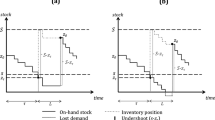Abstract
Errors in order forecasts are a salient source of inefficiencies in retail supply chains. Many operational decisions made by suppliers hinge on order forecasts, which typically are based solely on either order or point-of-sale (POS) history. Using a discrete-time formulation, this research demonstrates that if a supplier knows that a retailer is using a base stock policy, it should use that knowledge to forecast the retailer's orders, even if the supplier does not know the base stock level and/or have access to POS data.





Similar content being viewed by others
References
Aviv Y (2002). Gaining benefits from joint forecasting and replenishment processes: The case of autocorrelated demand . Manuf Serv Opns Mngt 4: 55–74.
Blinder AS (1982). Inventories and sticky prices . Am Econ Rev 72: 334–349.
Blinder AS (1986). Can the production smoothing model of inventory behavior be safe? Quart J Econ 101: 431–454.
Cachon G and Fisher M (2000). Supply chain inventory management and the value of shared information . Mngt Sci 46: 1032–1048.
Chen F, Drezner Z, Ryan JK and Simchi-Levi D (2000a). Quantifying the bullwhip effect in a simple supply chain. Mngt Sci 46: 436–443.
Chen F, Ryan JK and Simchi-Levi D (2000b). The impact of exponential smoothing forecasts on the bullwhip effect . Naval Res Logist 47: 269–286.
Croson R and Donohue K (2003). Impact of POS data sharing on supply chain management: An experimental study . Prod Opns Mngt 12: 1–11.
Dejonckheere J, Disney SM, Lambrecht MR and Towill DR (2004). The impact of information enrichment on the bullwhip effect in supply chains: A control engineering perspective . Eur J Opl Res 153: 727–750.
Fildes R, Nikolopoulos K, Crone SF and Syntetos AA (2008). Forecasting and operational research: A review. J Opl Res Soc 59: 1150–1172.
Forrester J (1958). Industrial dynamics . Harv Bus Rev 36: 37–66.
Gaviernie S, Kapuscinski R and Tayur S (1999). Value of information in capacitated supply chains. Mngt Sci 45: 16–24.
Graves SC (1999). A single-item inventory model for a non-stationary demand process . Manuf Serv Opns Mngt 1: 50–61.
Gruen TW and Corsten D (2007). A Comprehensive Guide to Retail Out-of-Stock Reduction in the Fast Moving Consumer Goods Industry, Grocery Manufacturers Association (GMA), Food Marketing Institute (FMI), National Association of Chain Drug Stores (NACDS), The Procter & Gamble Company (P&G), the University of Colorado, Colorado Springs, Co.
Gruen TW, Corsten D, and Bharadwaj S (2002). Retail Out of Stocks: A Worldwide Examination of Extent, Causes, and Consumer Responses. Grocery Manufacturers of America: Washington, DC.
Heyman D and Sobel M (1984). Stochastic Models in Operations Research . McGraw-Hill: New York.
Kahn J (1987). Inventories and the volatility of production . Am Econ Rev 77: 667–679.
Lee HL, Padmanabhan P and Whang S (1997). Information distortion in a supply chain: The bullwhip effect . Mngt Sci 43: 546–558.
Lee HL, So K and Tang C (2000). The value of information sharing in a two-level supply chain . Mngt Sci 46: 626–643.
Luong HT (2007). Measure of bullwhip effect in supply chains with autoregressive demand process . Eur J Opl Res 180: 1086–1097.
Poojari CA, Lucas C and Mitra G (2008). Robust solutions and risk measures for a supply chain planning problem under uncertainty . J Opl Res Soc 59: 2–12.
Porteus EL (2002). Foundations of Stochastic Inventory Theory. Stanford University Press: Stanford, CA.
Raghunathan S (2001). Information sharing in a supply chain: A note on its value when demand is nonstationary . Mngt Sci 47: 605–610.
Steckel JH, Gupta S and Banerji A (2004). Supply chain decision making: Will shorter cycle times and shared point-of-sale information necessarily help? Mngt Sci 50: 458–464.
Williams BD and Waller MA (forthcoming). Creating order forecasts: POS or order history? J Bus Logist.
Xu K, Dong Y and Evers PT (2001). Towards better coordination of the supply chain . Transport Res Part E: Logist Transport Rev 37: 35–54.
Author information
Authors and Affiliations
Rights and permissions
About this article
Cite this article
Williams, B., Waller, M. Estimating a retailer's base stock level: an optimal distribution center order forecast policy. J Oper Res Soc 62, 662–666 (2011). https://doi.org/10.1057/jors.2010.55
Received:
Accepted:
Published:
Issue Date:
DOI: https://doi.org/10.1057/jors.2010.55




